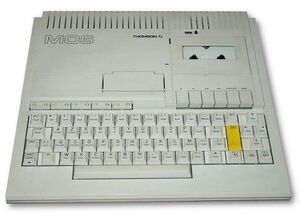Engineering:Thomson MO6
 Thomson MO6 | |
| Also known as | Olivetti Prodest PC128 |
|---|---|
| Manufacturer | Thomson SA |
| Release date | 1986 |
| Discontinued | 1989 |
| Media | Audio cassette |
| Operating system | BASIC 128 and Basic 1.0[1] |
| CPU | Motorola 6809E @ 1MHz |
| Memory | 64Kb ROM, 128kB RAM[1] |
| Storage | Audio cassette (1200/2400 bauds), disk drive (optional)[1] |
| Display | 8 modes from 160 x 200 to 640 x 200 with 2 to 16 colors (from 4096) |
| Graphics | Thomson EF9369 |
| Sound | 4 channels, 7 octaves |
| Input | 69 keys mechanical AZERTY keyboard, light pen[1] |
| Controller input | Joystick, Mouse [1] |
| Power | 200V, 24W |
| Dimensions | 362 x 87 x 315 mm |
| Mass | 3Kg |
| Backward compatibility | Thomson MO5[1] |
| Predecessor | Thomson MO5 |
The Thomson MO6 was a Motorola 6809E-based computer introduced in France in 1986.[2][3] It was intended as the successor to the Thomson MO5[4] and featured 128 KB of RAM, a 40×25 text display, and a new built-in Microsoft BASIC interpreter (BASIC 128[5]). It retained compatibility with its predecessor, while incorporating the same technology as the TO8.[6]
Graphic abilities were expanded compared to the MO5, by the use of the Thomson EF9369 graphics chip. The 16 colour palette could be defined from a total of 4096[5] and extra video modes were available:[5]
- 320 x 200 x 16 colours (2 colour per 8x1 pixels restraint)
- 640 x 200 x 2 colours
- 320 x 200 x 4 colours (no restraints)
- 160 x 200 x 16 colours (no restraints)
- 320 x 200 x 3 colours and one transparency level
- 320 x 200 x 2 colours (allows shifting between two screen pages)
- 160 x 200 x 5 colours with 3 transparency levels
In Italy it was sold by Olivetti with little aesthetic changes, and named Olivetti Prodest PC128.
21 games were released for the MO6.[7][8] The machine was available until January 1989.
Bibliography
- Garret, Yann (Sep 1986). "MO6, TO8, TO9+. Thomson présente sa nouvelle gamme." (in fr). Science & Vie Micro 31: 106–107. ISSN 0760-6516. http://www.abandonware-magazines.org/affiche_mag.php?mag=48&num=2230&album=oui.
References
- ↑ 1.0 1.1 1.2 1.3 1.4 1.5 "Thomson". Tilt - Jeux et Micro Guide 1989 (60): pp. 123–124. December 1988. https://download.abandonware.org/magazines/Tilt/tilt_numero060/TILT%20060S%20%28Jeux%20et%20Micro%20-%20Guide%201989%29%20-%20Page%20124.jpg.
- ↑ "Thomson MO6". https://www.old-computers.com/museum/computer.asp?c=167.
- ↑ "THOMSON JOUE LES LAPINS". Hebdogiciel Magazine (150): 1. August 29, 1986. https://ia800602.us.archive.org/14/items/hebdogiciel-french-150/hebdogiciel_numero_150.pdf.
- ↑ Garret, Yann (September 1986). "Thomson présente sa nouvelle gamma". Science & Vie Micro (31): pp. 107. ISSN 0760-6516. http://download.abandonware.org/magazines/Science%20et%20Vie%20Micro/svm_numero031/SVM31_p0107.JPG.
- ↑ 5.0 5.1 5.2 Thomson MO6 Guide. Thomson/SIMIV. 1986. https://www.musee-des-jeux-video.com/screenshots/Thomson%20MO6/doc/guidemo6_1.pdf.
- ↑ Miné, Antoine. "Thomson MO6 Emulation in MESS". https://www-apr.lip6.fr/~mine/mess/mo6.html.en.
- ↑ "Thomson MO6 video games (Hardware entity)" (in en). https://www.uvlist.net/groups/info/thomsonmo6.
- ↑ "Listing of all Thomson MO6 games - Page 1" (in en). https://www.video-games-museum.com/en/sys/69-thomson-mo6/3/all.
External links
- DCMOTO: PC emulator for Thomson MO5, MO5E, MO5NR, MO6, T9000, TO7, TO7/70, TO8, TO8D, TO9, TO9+ and Olivetti Prodest PC128. Comprehensive software and documentation are also available.
 |

